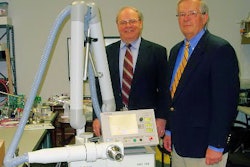Last month Philadelphia-based researchers confirmed that the risk of cardiotoxicity in women undergoing breast radiotherapy was quite low. Unfortunately, the same can't be said for potential damage to the lungs.
In a new paper, Hungarian oncotherapists found connections between patient age -- and other factors -- with the risk of early and late lung sequelae after conformal radiation treatment of breast cancer.
For their prospective analysis study, Dr. Zsuzsanna Kahán and colleagues at the University of Szeged in Szeged, Hungary, included 119 patients (average age of 58) who had undergone curative surgery for breast cancer, as well as radiotherapy. In this patient population, 95% of the tumors were invasive and 54% were node-negative. Thirty-five percent of the women were past or present smokers.
CT-based 3D treatment planning was performed with target volume and organs at risk (OARs) contoured on the CT slices on a radiotherapy planning systems (TMS, Nucletron, Veenendaal, Netherlands). In addition to local irradiation with two tangential photon beams, conformal radiotherapy was delivered by multiple 6/15-MV photon fields to the breast parenchyma/chest wall and the lymph nodes when indicated. The dose was 25 x 1.8-2 Gy. The tumor bed was irradiated either with 6-MV photon or 8-15-MeV. Radiotherapy was delivered with a linear accelerator (Mevatron KDS-2, Siemens Medical Solutions, Malvern, PA) in five fractions per week.
"We defined the percentage volume of the ipsilateral lung receiving at least 20 Gy (V20Gy) as < 25%, and endeavored to keep the volume of the ipsilateral lung irradiated with 25 Gy or more, under 25% (D25% = 25 Gy) as optimal thresholds," the authors explained (International Journal of Radiation Oncology, Biology, Physics, July 1, 2007, Vol. 68:3, pp. 673-681).
Transforming growth factor (TGF-ß) levels were measured from blood samples. An ancillary objective of this study was to see if the plasma TGF-ß level pre- and postradiotherapy could predict early or late radiogenic lung damage, the authors stated. Patients were followed at three-month intervals with the authors looking at lung damage and lung density measurements.
According to the results, 37% of the 119 patients had grade 1 pneumonitis but only 9% showed clinical symptoms. Significant associations were found between the development of pneumonitis and patient age, mean lung dose (MLD), V20Gy, and D25%. In addition, grade 1 pneumonitis seemed to be associated with radiation to the supraclavicular and axillary lymph nodes. Lung density measurements at the level of the left heart ventricle (MDCLHV) increased significantly three months after radiation treatment in these patients.
Late radiation sequelae were seen in 113 patients with 35.4% developing grade I fibrosis, but none had clinical symptoms. The presence of inflammatory changes at three months was strongly correlated with fibrotic abnormalities at one year. Again, age was associated with the development fibrosis, as was V20Gy and D25%. Fibrotic abnormalities were associated with MDCLHV lung density measurements.
With regard to TGF-β, levels before and after radiotherapy were not related to radiogenic lung damage, the authors stated, although patients with pneumonitis did have significantly higher TGF-β levels three months after treatment.
Finally, the authors noted that smokers actually had a lower rate of early radiogenic lung damage. Also, no meaningful association was found between fibrotic changes and smoking habits. One possible explanation for this outcome could be the immunosuppressive effect of cigarette smoking and nicotine, the authors stated.
"We found a 37% incidence of radiation grade I pneumonitis and a 35.5% incidence of grade I radiation fibrosis in breast cancer patients after conformal adjuvant radiotherapy," the group explained. "Inclusion of the lymph nodes in the irradiated volume clearly increased the radiation dose to the lung. We observed that the irradiation of the axillary and supraclavicular lymph nodes increased the risk of pneumonitis and fibrosis."
They concluded that age (older than 59 years) was the predominant risk factor for lung damage, followed by the volume of irradiation lung and radiation dose.
By Shalmali Pal
AuntMinnie.com staff writer
July 24, 2007
Related Reading
ASCO study: Curtailed radiotherapy effectively treats breast cancer patients, June 28, 2007
Breast radiotherapy studies propose shorter treatment, confirm lack of cardiac risk, June 13, 2007
Copyright © 2007 AuntMinnie.com



















